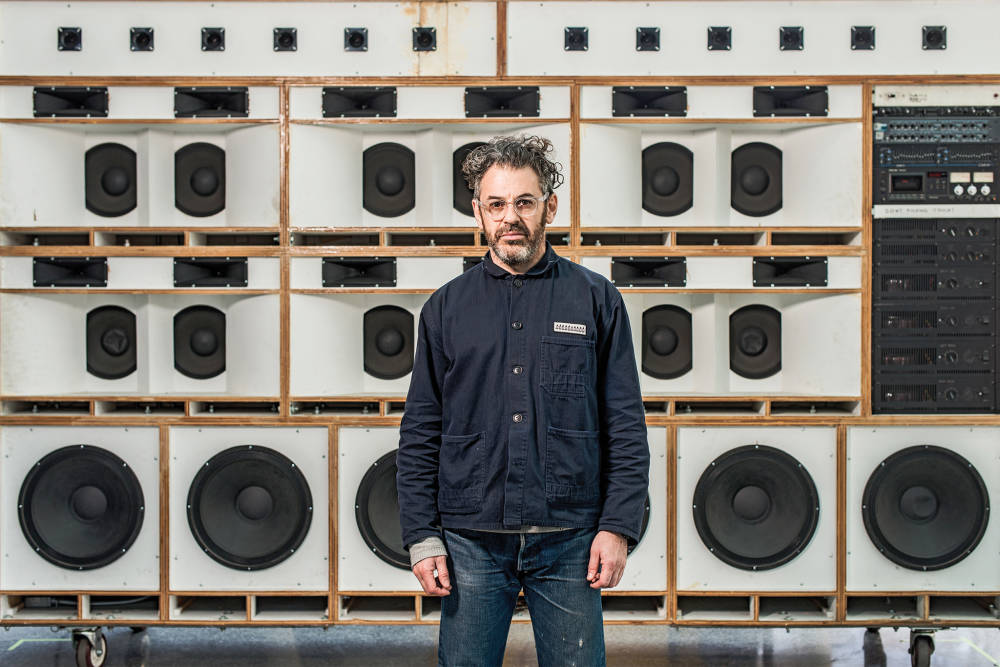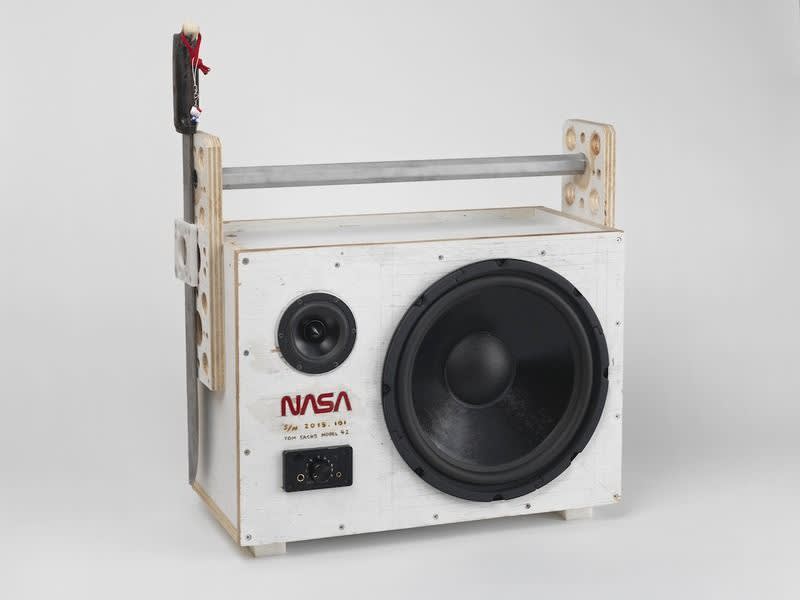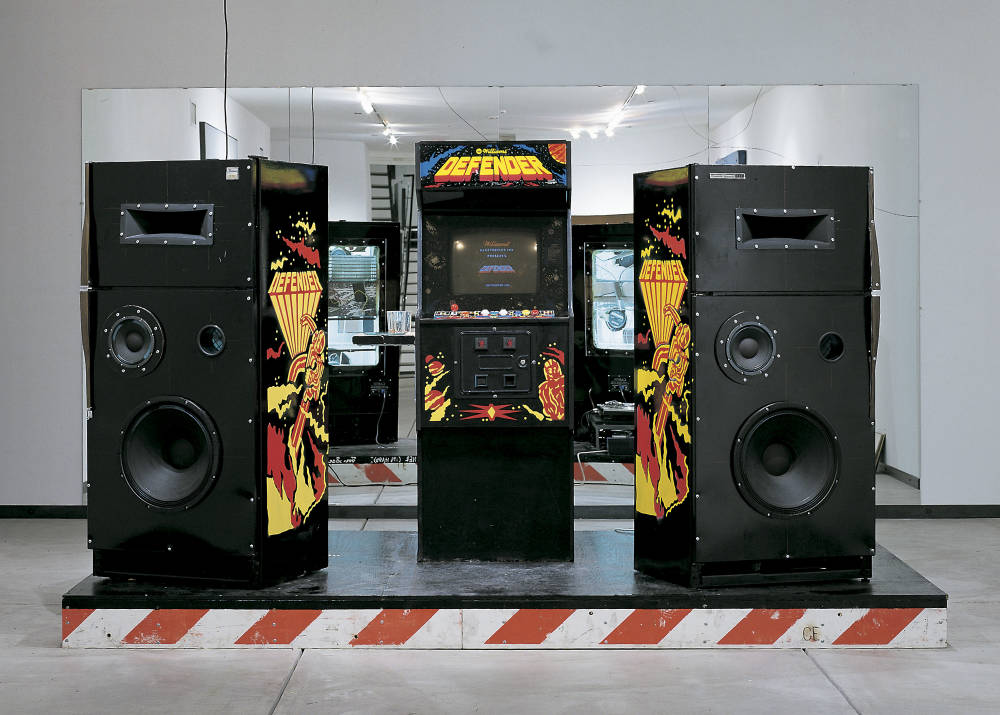
Tom Sachs
The Brooklyn Museum, Boombox Retrospective, 2016
Music is, of course, an auditory experience. But like all artforms, the messages, communities, and philosophies concealed within vocal and instrumental sounds naturally have a way of becoming visual experiences. Driven by this notion, artists have historically enlisted music as their muse, working to aesthetically capture the sounds that make up this acoustic artform, as well as the culture that it inspires. None of whom have perhaps done so more successfully than New York-based artist Tom Sachs, through his ongoing series of boombox sculptures.
We know it as the portable radio of urban youth, the preferred sound system of dance battles, and an icon of 80’s 90’s Hip Hop, but for Sachs, the boombox is also an experimental medium through which he’s able to engaged with his lifelong passion for music. Given the sound system’s natural way of marrying art, utility, technology, and cultural icons of the past and present, the boombox is an unsurprising muse for the contemporary artist. Even before achieving worldwide recognition for his sculptural works that borrow from consumer society, oftentimes incorporating utilitarian elements and found objects, Sachs was making sound systems for the purpose of his own listening pleasure. Only later would this highly influential body of work become a format for commentary within his larger artistic oeuvre.

Tom Sachs
AAU (Acoustic Amplification Unit) MK II, 2015

Tom Sachs
AAU (Acoustic Amplification Unit) MK II, 2015
Akin to the breadth of his career, Tom Sachs’ boomboxes feature nods to consumerist icons – such as McDonalds and BMW – and the red rocks from the artist’s ‘Space Program: Mars’ series, as well as his penchant for found objects and steadfast use of raw, repurposed materials. As such, Tom Sachs is able to employ the boombox as both a utility of the past and a contemporary nod to his handcrafted aesthetic.

Tom Sachs
Boombox Retrospective, 1999-2016

Tom Sachs
Model Twenty Eight, 2012

Tom Sachs
Sochin, 2014
In many ways, Sachs’ 2016 Boombox retrospective at New York’s Brooklyn Museum was actually, in fact, a Tom Sachs career retrospective by way of the boombox. Cataloging the DIY-esque speaker systems he’s been creating since 1999, the eighteen works included in the show featured a variety of media ranging from porcelain and plywood, to metal and cast bronze; highlighting the artist’s one-of-a-kind ability to inventively transform ordinary, everyday materials into art.

Tom Sachs
Clusterfuck, 2015

Tom Sachs
Model One, 1999

Tom Sachs
Boombox Retrospective, 1999-2016
Engineered for the purpose of playing music, the visual symbol of a boombox ultimately carries greater social symbolism when exploring its significance throughout the history of various cultures. Sachs’ Brooklyn Museum retrospective nodded at this underlying narrative through a sound component inspired by Brooklyn’s rich history of street music. Meanwhile, the rise of streetwear in fashion and artistic trends of 1980s street art made the sentiment of this 2016 exhibition all the more timely. In this way, Tom Sachs’ mechanically engineered sound systems are able to bring up abstract questions around music and culture. For starters, how do different genres of music visually present themselves? And to what extent is music a tool for belonging, for creating culture, or for promoting a certain type of lifestyle?
Tom Sachs
Boombox Retrospective, 1999-2016
Tom Sachs
Boombox Retrospective, 1999-2016
Tom Sachs
Guru's Yardstyle, 1999
Tom Sachs
Model Thirty Six, 2014
Tom Sachs
Model Thirty One/Model Twenty Nine, 2013
Moreover, Tom Sachs is able to examine the philosophical and technical elements of certain music genres and give them a physical presence through the machine. The eclectic combination of sounds that make up reggae music, for example, is reflected through the numerous parts, objects, and speakers that make up the boomboxes through which it is played.

Tom Sachs
Boombox Retrospective, 1999-2016

Tom Sachs
Boombox Retrospective, 1999-2016

Tom Sachs
Sarah, 2014
What started as a mode of projecting sound becomes an artistic commentary on the history of music and the people who are listening. Yes, Tom Sachs’ Boombox sculptures are auditory machines, but in many ways, they project so much more than just the sound of music.

Frank Ocean
Endless Video, with Tom Sachs Boombox, 2016

Tom Sachs
Toyan's, 2002



